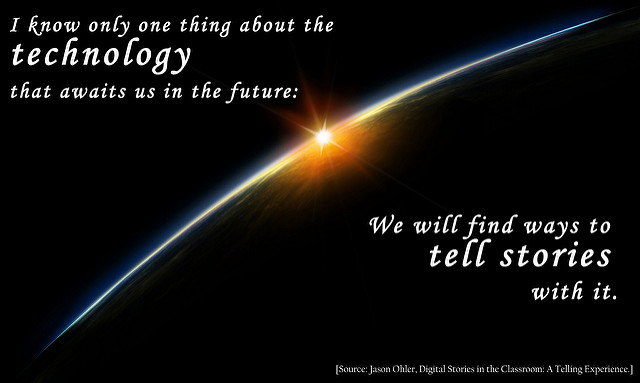March 2, 2023
A Story of Change https://vimeo.com/110722454 |
- Sign in and stow your phones out of sight. Log into a Chromebook and complete the WYAW activities.
- KWL: Digital Storytelling? What do you think you know? Tell us on Whiteboard.fi (https://whiteboard.fi/) REMINDER: Do this by tables - collaboration, creativity, critical thinking, communication (4Cs!)
- Table Groups: Using your Vintage Whiteboards, choose three or more words or phrases you can think of to describe the intro story from Katie Cahn. What do you notice about the visuals and narration? How much music is used and for what purposes? Divide the board in two and on one side list 2-3 positives about the creative aspect of the story and on the other side, 2-3 positives about the technical aspects.
- A little history of digital storytelling from StoryCenter formerly known as The Center for Digital Storytelling (:01 to 5:16) Let's hear from Joe Lambert about some groovy artists and community activists wanting to tell their story to the world and a powerful example of the first "official" digital story that we'll discuss. What is your response? NOTE: This is storytelling by adult makers/tellers.
- Joe Lambert from StoryCenter (formerly the Center for Digital Storytelling) developed Seven Elements of a Digital Story (brief available in PDF format). Another researcher/practiotioner of note is Bernard Robin at the University of Houston.
Lambert has multiple editions of the book, (Digital Storytelling Cookbook, 2003; Digital Storytelling Cookbook, 2010; Seven Stages: Story and the Human Experience, 2013; Digital Storytelling: Capturing Lives, Creating Community, 2018). What do these elements look like and how might you assess digital stories using this framework as a guide?

Photo by Silvia Rosenthal Tolisano
- Story break: Let's view some examples of digital stories from past classes. Format: Two compliments.
- Two from Kenyan Travelers:
- Amber H. https://vimeo.com/298544365
- Cora Weeks https://vimeo.com/191380352 (PW)
- Matt T. https://vimeo.com/400416586 (PW)
- Two from Kenyan Travelers:
- WeVideo Studio Time. Log into WeVideo https://www.wevideo.com/ with your class gmail account!
LEARNING GOALS (SKILLS):- Title and Credits
- Using the stock media in WeVideo (we pay - paid subscription)
- Adding images and video and editing continued
- Recording narration and adjusting volume
- Adding music and adjusting volume
- Adding titles over an image or video
- Finishing and getting the published link
BE THINKING.....
- A link to your personal digital story from WeVideo once it has been "Finished" and published. DON'T link to your editing/timeline environment. You may also use a video sharing service such as Vimeo (with password) if that is your preference but is not required.
- Your script for the project using the format discussed in class.
- The personal digital story reflection using the designated word template for in Canvas under Assignments
(filename: "personal_digital_story_reflection_2023.docx").
- You can see all the requirements for this assignment and how you will be assessed by viewing the rubric in Canvas.
Start thinking about a personal story you want to tell. The focus is on Stories of Challenge and Change but within this broad topic, it can be a personal story of your choice. There are some "must haves" including visuals, narration, duration (between 1:30 and 4:00 minutes), and a title and credits. Otherwise, you can include also - video, sound effects, music, and animations. Want to try out chroma key (green screen) - go for it!
DIGITAL STORYTELLING ASSIGNMENT:
Your Personal Digital Story:
This is an open-ended story that can be about any story within the broad topic of Stories of Challenge and Change. This assignment has three parts and ALL will be submitted in Canvas:
RESOURCES O' THE DAY:
THE Source for Digital Storytelling: http://www.storycenter.org/
THE Top Academic Source for Digital Storytelling: http://digitalstorytelling.coe.uh.edu/
More about StoryCenter (formerly the Center for Digital Storytelling) http://www.storycenter.org/press/
